Federal Workforce Priorities Report
About the Report
2022 Federal Workforce Priorities Report Effective April 11, 2017, Title 5, Code of Federal Regulations, Part 250, Subpart B, Strategic Human Capital Management required the Office of Personnel Management (OPM) to issue the quadrennial Federal Workforce Priorities Report (FWPR or the Report). The Report communicates key governmentwide human capital priorities intended to inform agency strategic and human capital planning. Agencies, defined as those included in the Chief Financial Officers Act of 1990 and subsequently the Chief Human Capital Officers Act of 2002, are required to align their human capital management strategies to support the Report, as demonstrated in Human Capital Operating Plans (HCOPs). The human capital regulation governing the FRWP requires those agencies to support and incorporate the Report priorities within their HCOPs.
OPM established the Report by regulation in response to the first recommendation in the Government Accountability Office (GAO) report, “Human Capital: Strategies to Help Agencies Meet Their Missions in an Era of Highly Constrained Resources” (GAO-14-168). Therein, GAO recommended that OPM strengthen coordination and leadership of governmentwide human capital issues. One of two key supporting actions was the development of a governmentwide human capital strategic plan. Building upon this idea, OPM established the FRWP to identify governmentwide human capital priorities based upon current and emerging workforce challenges. The Report, however, is not intended to serve as a plan that obligates the human capital community to specific actions, time frames, and measures of success. Rather, the President’s Management Agenda and Cross-Agency Priority Goals create a process for establishing such governmentwide requirements, and when developing human capital goals, the Report may be considered as a source for useful insights and strategies.
Agencies are required to engage in activities to support the priorities, while maintaining flexibility and autonomy in how they do so. HCOPs should document supporting agency efforts, including time frames and performance measures. Evaluation initiatives, such as HRStat, Independent Audits, and Human Capital Reviews, are intended to help monitor progress, assess effectiveness, and refine strategies. The HCOPs, in turn, may be updated annually, as needed and determined by each agency. Therefore, the priorities should be implemented by agencies within various stages of the human capital management cycle.
Within this Report, “agencies” refers to those included in the Chief Financial Officers Act of 1990 and subsequently the Chief Human Capital Officers Act of 2002. The human capital regulation governing this Report requires those agencies to support and incorporate the Report priorities within their HCOPs.
2022 Federal Workforce Priorities Report Highlights
Priorities
The research led OPM to focus on three areas for the 2021 FWPR: People, Platforms, and Processes. As the COVID-19 pandemic unfolded in 2020, OPM recognized that these were vital focus areas for any post-pandemic government workforce and workplace. In addition, Administration priorities will clearly focus on the elimination of systemic racism, pandemic response and eradication, diversity, equity, inclusion, and accessibility, economic stability, climate change, national security, recruitment of a world class workforce, and the strengthening the civil service so it works for all Americans. Understanding that within any agency, people use platforms to complete processes that facilitate effective management and achieve mission success, we believe these three pillars are critical to running an efficient and effective government enterprise. We also recognize that the world continues to rapidly change and evolve. COVID-19 is still impacting daily life for every American and though the economy continues to rebound it is still recovering from the pandemic. These priorities, grounded in rigorous research, are a foundation for the future and should assist agencies in long-term strategic planning for future success.
- Recruitment, Succession Planning, and Knowledge Transfer
- Enhancing Employee Experience, Fostering Employee Well-Being, and Building a Diverse and Inclusive Workforce
- Fostering and Agile Organization and the Growth Mindset
- Enhancing Customer Experience
- Preparedness and Resilience
- Leveraging Technology and Modernizing IT Processes
- Leveraging Data as a Strategic Asset
- Developing an Agency Foresight Capability
It is also vitally important to recognize the successes and efforts agencies have achieved with the current workforce priorities, celebrate those successes, and pass on the lessons learned so other agencies may achieve similar successes. In order to ensure that agency efforts based on the previous report can continue and expand, the new priorities identified in this report align with the previous priorities from the 2018 Federal Workforce Priorities Report.
The priorities are organized under the rubric: People, Platforms, and Processes. This organization strategy was initially designed by OPM but in order to gather agency feedback and ensure that the priorities resonated with the HR community and senior leadership within the government, several additional focus groups were convened. In October 2021, the focus groups, comprised of Chief Human Capital Officers, Deputy Chief Human Capital Officers, and Human Capital experts were convened to discuss the notional priorities. While it was clear that all eight priorities resonated with the assembled participants, four of the priorities rose to the top. Considering these findings, OPM decided to maintain the People, Platforms, and Processes rubric but add an additional layer of delineation. Within the overall organization, four of the priorities are also assigned the label of Primary and the remaining four priorities are assigned the label of Enabling. Agencies are required to work on two of the primary priorities and leverage the enabling priorities to the maximum extent possible to support their efforts.
The enabling priorities will have a direct impact on successful implementation of the primary priorities. In addition, the enabling priorities are critical for designing visionary strategies, identifying metrics for success, and measuring progress over the next four years. The enabling priorities are foundational for future success and critical to sound Human Capital Management. Agencies should focus their efforts on two primary priorities but recognize that they will need to use the concepts espoused by the enabling priorities to maximize their success.
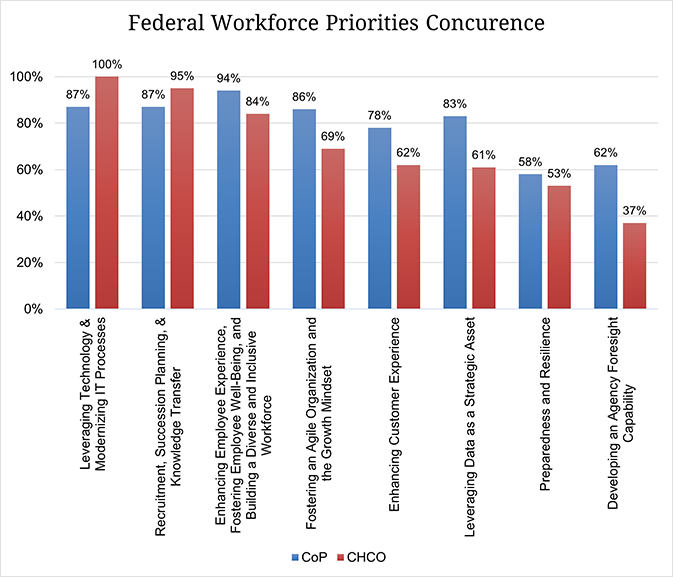
Federal Workforce Priorities Concurence Image Details
Priorities in the Context of People: Building, Maintaining, and Empowering a 21st Century Workforce
Agencies can no longer afford to react to workforce and technological changes when they occur. While agencies continue to systematically identify the required workforce skills, roles, and competencies, they should also anticipate changes and plan early to successfully address future opportunities and challenges.
Agencies understand the workforce is changing, and the Federal Government must change with it. All agencies must recommit to branding their work to ensure that they are doing their best to attract the next generation of government employees and providing them the necessary career-path to retain that talent. In addition, it should be made clear that every Federal job is vital to the success of the American republic and that civil service is critical to maintaining our democracy and ensuring the vulnerable and underserved populations are not neglected. Every Federal job is an important job!
Diversity, equity, inclusion, and accessibility (DEIA) lies at the heart of civil service. Within the Federal workplace, all are welcomed and empowered because, through DEIA, the workforce is stronger, smarter, and more efficient and effective. The new PMA internalizes these vital concepts and provides pillars that can assist agencies in implementing the priorities in this report.
Finally, workforce decisions must be based on sound and relevant data, and an understanding of the future operating environment, to empower and engage employees to maximize their talents, realize their full potential, and preserve institutional knowledge. The first five priorities were designed to assist agencies in achieving these goals.
Priorities in the Context of Platforms and Processes: Utilizing Data, Foresight, and Technology to Optimize Performance
The Federal Government should identify ways to transform agencies’ processes and practices to meet modern-day human capital management and human resources operational challenges now and in the future. Agencies must modernize human resources IT infrastructure by upgrading and integrating enterprise IT systems supporting the workforce and increasing the data available to inform management decision-making.
Agency strategic plans should focus on long-term objectives. During formulation of the plan, it is important that agencies consider current risks and how those risks evolve over time. Strategic goals should include initiatives to optimize HR service delivery and explore ways to standardize core HR processes across all business units. They should implement efficient, cost-effective, and customer-focused service delivery models that consider future occupations and different ways of performing Federal work. Agencies should transform the employee performance and engagement culture by identifying, addressing, and remedying any disparities in access or participation, empowering, and encouraging employees to maximize their talent, and enhancing agency performance management programs to motivate, reward, and recognize high performance.

Primary Priorities
Leveraging Technology and Modernizing IT Processes
Research, acquire, and develop enterprise technological solutions to assist the Federal human capital community with human capital analysis; increase data available to inform management decision-making and to support the workforce.
Traits of this priority include ensuring sufficient cybersecurity talent, providing the latest data analytical software, and removing barriers from implementation, ensuring systems meet all security protocols and data integrity, and maximizing IT infrastructure.
Recruitment, Succession Planning, and Knowledge Transfer
Adopt, continue, or enhance succession planning activities to retain and transfer institutional knowledge as workforce reshaping efforts are undertaken.
Traits of this priority include technology training, implementing phased retirement, next-generation workforce recruitment, competency assessments, skills inventories and leadership skills and capabilities training initiatives.
Enhancing Employee Experience, Fostering Employee Well-Being, and Building a Diverse and Inclusive Workforce
Adopt policies, procedures, and processes that provide an exceptional employee experience and support accessibility, and health-focused activities to enable employees to function at peak performance through a diverse workforce.
Traits of this priority include health and wellness support, diversity and inclusion strategies, fair and equitable treatment of all employees, accessibility, and ensuring strong performance management processes.
Fostering and Agile Organization and the Growth Mindset
Empower employees to adapt to organizational changes, utilize tools to build critical digital and cognitive abilities: affect meaningful change management: and cultivate the growth mindset allowing employees to connect, communicate, and collaborate easily with peers and colleagues.
Traits of this priority include retraining, reimagining work, skills assessment, competency assessments, career path tools, and other mechanisms to promote an agile organization.
Enabling Priorities
Enhancing Customer Experience
Leverage new technology, build strong partnerships, and increase transparency to enhance service delivery, improve agency-customer relationships, and promote trust in legacy and new government institutions.
Traits of this priority include academic alliances, user and customer service surveys, user-friendly, transparent websites with critical information, and timely guidance and response to inquiries.
Leveraging Data as a Strategic Asset
Adopt policies, processes, and platforms to ensure the gathering, curation, and analysis of data is effective, secure, and contributes to informed, timely, and data-informed strategic decisions.
Traits of the priority include using dashboards to drive agency human capital efforts, sustain HRStat data-driven reviews that are aligned with independent program audits, ensure that teams have the necessary data analytics skills, and implement data sharing and data governance policies.
Preparedness and Resilience
Adopt policies, procedures, and contingency plans to proactively identify significant future disruptive events and prepare agencies to adapt to whole-of-workforce needs to ensure the safety and security of the future workforce.
Traits of this priority include a continuation of work plan, an infrastructure to support pandemic-like conditions, understanding environmental impact and technology infrastructure to ensure continuity of operations, and periodic agency-wide emergency drills/simulation events to test and refine agency plans and infrastructure.
Developing and Agency Foresight Capability
Leverage the power of strategic foresight methodologies to minimize surprise and create an anticipatory governance and planning culture at all agency levels; where employees, regardless of their position in the agency, think and act with strategic intent.
Traits of this priority include conducting future scenario planning, identifying emerging skills, and implementing proven methodologies to identify future challenges.
Federal Workforce Priorities Concurence
| Priority | COP | CHCO |
|---|---|---|
| Leveraging Technology & Modernizing IT Process | 0.87 | 1 |
| Recruitment, Succession Planning, & Knowledge Transfer | 0.87 | 0.95 |
| Enhancing Employee Experience, Fostering Employee Well-Being, and Building a Diverse and Inclusive Workforce | 0.94 | 0.84 |
| Fostering an Agile Organization and the Growth Mindset | 0.86 | 0.69 |
| Enhancing Customer Experience | 0.78 | 0.62 |
| Leveraging Data as a Strategic Asset | 0.83 | 0.61 |
| Preparedness and Resilience | 0.58 | 0.53 |
| Developing an Agency Foresight Capability | 0.62 | 0.37 |
Priorities in the Context of People & Priorities in the Context of Platform and Process
The graphic shows the relationship between the eight priorities identified in this report. People were the focus of the first five priorities which are depicted as arcing around a magnifying glass symbolizing the research and study the OPM conducted. The final three priorities focused on platforms and processes. People are the most important part of the government and the focus of this report; therefore, those priorities are depicted on the top of the magnifying glass while the final three are depicted on the bottom since they support the people of the organization.
Priorities Crosswalk
The work agencies are doing to address the previous priorities should continue within the context of the new priorities. The crosswalk below illustrates how the priorities from the FWPR 2018 link to the priorities in the FWPR 2022. Agencies should continue their efforts on the 2018 initiatives under an improved rubric.

View the Priorities Crosswalk chart in 2022 Federal Workforce Priorities Report - Page 30
Supporting Analysis
The Office of Personnel Management (OPM) began conducting research in 2019 to identify current and future workforce risks, challenges, and opportunities. Using the STEEP (Social, Technological, Environmental, Economic, and Political) environmental scanning framework, OPM gathered a significant amount of information on both the internal state of the Federal Government and the external environment. When COVID-19 began impacting the workplace, the research team expanded its research on preparedness and resilience as a future priority.
The following is a brief list of document repositories and legislation the research team analyzed when formulating the support for each priority. This is not an all-inclusive list. Additional references supporting the priorities are listed at the conclusion of this report.
- The President’s Annual Budget for Fiscal Year 2021
- Budget of the U.S. Government - Fiscal year 2022
- The President’s Management Agenda
- The Biden-Harris Administration Immediate Priorities
- Office of Management and Budget Launches Biden-Harris Management Agenda Vision
- The Foundations for Evidence-Based Policymaking Act of 2018
- Federal Employee Viewpoint Survey
- IT Spending Dashboard & Makor Projects List
- Office of E-Government & Information Technology
- Government-wide Strategic Plan to Advance Diversity, Equity, Inclusion, and Accessibility in the Federal Workforce
- Inspector General Management Challenges
- Government Accountability Office Reports and High-Risk Lists
- Congressional Reports
- Human Capital Operating Plans
- Human Capital reviews
To identify priorities, OPM reviewed a myriad of documents using a variety of methods, including the use of text mining programs that identified key words, themes, and phrases. These documents allowed OPM to understand the various challenges faced by agencies since the publication of the previous FWPR and what new challenges lay beyond the horizon.
ON THIS PAGE
Workforce of the Future
The post-pandemic future will present both challenges and opportunities for the federal workforce. A new era of innovation, creativity, digitization, resiliency, collaboration, and flexibility is rapidly evolving. The Federal Government, especially agency leaders, should embrace the change and ensure that their organizations are ready, willing and able to leverage the opportunities and thrive in the future!
There are three generations in the Federal workforce today: Generation Y (aged 25-40) 26%, Generation X (aged 41-56) 45%, and Baby-Boomers (aged 57-75) 29%. Federal government new hires make up is changing. The younger Federal workforce, Generations Y and X’s values, culture, and career priorities are much different than those of baby-boomers and previous generations. They prioritize a work-life balance. They prefer a work environment allowing flexible schedules and remote work options. They value collaboration and feedback and like to touch base with their managers more often. Generations Y and X are more racially and ethnically diverse, better educated, and more digitized than baby-boomers and previous generations.
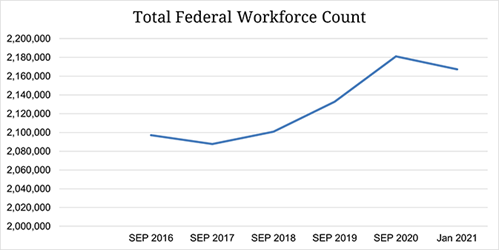
Source: OPM FedScope
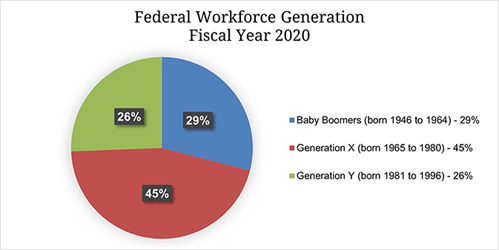
Source: OPM FedScope
References
20 New HR Trends & Predictions for 2021 You Should Be Thinking About
This Is How Generation Z Employees Want Feedback
On the Cusp of Adulthood and Facing an Uncertain Future: What We Know About Gen Z So Far
The future of the Federal workforce must consider younger employees (Generations Y and X), older employees (Baby-Boomers), working styles, and shifting personal and career values. Federal policies need to be structured to retain the next generation workforce while accommodating and empowering current employees. Agencies should consider flexible work schedules and tools for effective collaboration tailored to each groups’ working style.
The changing workforce indicates a need to prepare for this inter-generational work contact and to address apprehensions both about hiring younger as well as older workers (Fassbender and Wang 2017).
Percent of Federal Workforce 2016-20 by Age Group
| Age Group | SEP 16 | SEP 17 | SEP 18 | SEP 19 | SEP 20 |
|---|---|---|---|---|---|
| Less than 20 | 0.1% | 0.1% | 0.1% | 0.1% | 0.1% |
| 20-24 | 1.9% | 1.8% | 2% | 2.2% | 2.3% |
| 25-29 | 5.9% | 5.6% | 5.6% | 5.8% | 6% |
| 30-34 | 10.7% | 10.4% | 10.1% | 9.9% | 9.7% |
| 35-39 | 12% | 12.4% | 12.8% | 13% | 13% |
| 40-44 | 11.2% | 11.4% | 11.7% | 12.2% | 12.8% |
| 45-49 | 13.9% | 13.7% | 13.5% | 13.1% | 12.7% |
| 50-54 | 16.2% | 15.8% | 15.1% | 14.6% | 14.3% |
| 55-59 | 14.4% | 14.6% | 14.7% | 14.7% | 14.5% |
| 60-64 | 9% | 9.2% | 9.2% | 9.3% | 9.3% |
| 65 or more | 4.7% | 4.9% | 5% | 5.2% | 5.3% |
Source: OPM FedScope
Agencies should promote existing incentives already in place to make the Federal Government an attractive place to work for the next generation workforce. These could include AWS and Telework flexibilities. Federal Government guidelines promote inclusive work environments (GAO-19-696T) and promote awareness among managers of existing incentives appealing to potential employees (e.g. work-life balance programs) (GAO-19-723T). Furthermore, the Federal Government should provide stable employment in the face of societal upheavals, such as the COVID-19 pandemic crisis. Even in ordinary times, agencies should make employees and potential applicants more aware of existing opportunities to manage life events (GAO-19-723T).
Percent of Federal New Hire Workforce 2016-20 by Age Group
| Age | FY 2016 | FY 2017 | FY 2018 | FY 2019 | FY 2020 |
|---|---|---|---|---|---|
| Less than 20 | 2.12% | 1.94% | 1.7% | 0.9% | 0.2% |
| 20-24 | 13.9% | 14.5% | 15% | 14.1% | 13.1% |
| 25-29 | 18.7% | 18.8% | 18.2% | 17.8% | 17.3% |
| 30-34 | 16.5% | 16.1% | 15.7% | 15.8% | 15.9% |
| 35-39 | 11.8% | 11.9% | 12.1% | 12.6% | 13.1% |
| 40-44 | 9.7% | 9.1% | 9.3% | 9.7% | 10.2% |
| 45-49 | 9.1% | 8.8% | 8.9% | 8.7% | 9% |
| 50-54 | 7.6% | 7.5% | 7.4% | 7.5% | 7.7% |
| 55-59 | 5.5% | 5.7% | 5.8% | 5.9% | 6% |
| 60-64 | 3% | 3.1% | 3.1% | 3.2% | 3.1% |
| 65 or more | 2% | 2.4% | 2.2% | 2.4% | 2.2% |
Source: OPM FedScope
Key Research Takeaways
- Generations Y and X employees tend to value freedom to use and develop diverse skills in a variety of experiences. (Gallup 2017) (NAPA 2018)
- Generations Y and X employees are “digital natives”, tending to have different conceptions of transparency, responsiveness, and openness to change. (NAPA 2018) (Volker Alliance 2018)
- Generations Y and X employees have different expectations for workplace culture and prefer flexible online and cohort-based trainings to facilitate networking. (IBM 2019)
- One-third of all Generations Y and X employees plan to leave the Federal service, of which half plan to do so in the next one-to-three years, according to a 2015 study. (NAPA 2017)
- Most “young leaders” of the Generations Y and X employees, 75%, plan to stay in public service long-term and 63% of these young leaders have trusted mentors in government. (Volker Alliance)
Key Priority Insights
In the future, AI and new technologies can strengthen human capital management policies and practices.
- AI and other technologies could change the face of recruitment, interviews, on-boarding, training, and performance monitoring. (Gikopoulos 2019)
- Depending on how it is implemented, AI and automation could reinforce bias or present opportunities to lower bias in recruitment and hiring. (Gikopoulos 2019) (GAO-18-142SP) (IBM 2019) (NAPA and KPMG 2019, p. 9-10)
- Current laws and regulations for AI are not uniformly adequate. GAO suggests using pharmaceutical regulations as a guide. (GAO-18-142SP)
- Government could facilitate regulatory sandboxes to promote innovation and access to regulatory approaches. (GAO-18-142SP)
- AI can and should be used to augment human decision making, rather than just replace it. (IBM 2018, p. 31-32)
- Governments support private industries in providing electronic government services to customers who increasingly carry out their business on smart and mobile devices. (Agarwal 2018, p. 919)
The need for and ubiquity of new technologies will force governments to restructure and rethink their IT infrastructure.
- Investments in upgrading and modernizing IT infrastructure are crucial. AI can be an add-on to legacy systems, but long-term plans should place it at the center of planning efforts. (IBM 2018) (Volker Alliance 2018)
- The use of Cloud Computing and Open-Source technology can expand IT interoperability. (IBM 2018, p. 22-23) (Taylor 2017)
- Agile governance and acquisition practices for IT will be critical. (IMB 2018)
- The adoption of cloud-based systems to replace outdated systems can increase moral and lower organizational resistance to technology adoption that may disrupt existing practices. (IBM 2018, p. 25)
- Public cloud infrastructure and usages is linked to better project delivery time (Taylor 2017, p. 111)
- Data intensive problems could benefit from the adoption of machine learning and AI. (IBM 2018, p. 25)
- Awareness of potential impacts of advanced technologies can be enhanced through exploratory projects. (IBM 2018, p. 33-34)
- The use of third-party arbiters to investigate algorithmic and AI-based decision making could be helpful. (IBM 2018)
- AI use should be aligned to mission and agency purpose. (NAPA 2019)
- Increased reliance on AI requires a more networked and inter-connected government. (NAPA and KPMG 2019, p. 9-10)
- Data managers, knowledge integration managers, and “customize” service managers will become increasingly important in the federal sector. (NAPA and KPMG 2019, p. 9-10)
- Funding in direct support of infrastructure modernization and migration of trust fund financial system will be needed. (OPM OIG 2018, p. 9)
- GAO estimates 25% of Federal technology budget currently supports development, modernization, and improvement of IT systems while 75% of budget resource are used for maintaining pre-existing legacy systems. (Volker Alliance 2018)
Increasing reliance on machine learning, bots, artificial intelligence, and automation presents new challenges surrounding ethics and equity.
- Automating government decision-making cannot be framed solely as an issue of implementation, but rather must be situated by the high impact of legal choices made by agencies. (Schartum 2019)
- There is a risk that a handful of people or companies will consolidate control over new technologies leading to agency dependence on fewer providers. (Agarwal 2018, p. 918)
- long-term, new technologies that replace or augment significant portions of the workforce could lead to demands to alter the work week structure. (Agarwal p. 918-920) (IBM 2018)
- Shift the focus away from automation-replacing-employees towards a mindset of technology augmenting the capabilities and performance of existing (and future) workers. (CNES, p. 10)
- Prioritize value-setting designs that are in-line with social and ethical concerns. (IBM 2018, p. 36) (Schartum 2019)
- Be aware of growing privacy concerns surrounding new technologies. (IBM 2018) (NAPA and KPMG 2019)
- The use of AI and automation is not inherently neutral but reflects the bias of creators and the environments that dictate what data is collected, mined, and used. (Agarwal 2018, p. 920) (GAO-18-142SP) (IBM 2018) (NAPA 2019) (NAPA and KPMG 2019) (Schartum 2019)
- Agencies must be transparent regarding how categories and questions used in automated application processing. (Schartum 2019, p. 17-19)
- Some project 51% of tasks and nearly 5% of jobs will be fully automated by 2035. (GAO-18-142SP, p. 45)
- Protocols and systems must be developed to address ethical questions and disadvantages of AI. (NAPA 2019, p. 12) (Schartum 2019)
- It is important to ensure that AI adoption is guided by clear objectives and allows for a significant role for humans. (NAPA and KPMG 2019, p. 11-12)
- Revenue streams could change or decline as certain goods and services are replaced or become obsolete due to technological change. (Agarwal 2018, p. 920)
Agile principles and continuous learning will empower employees and reimagine government.
- The future of the Federal Government workforce demands greater institutional agility as the global pandemic continues to disrupt norms and accelerate change.
- Using agile practices should be perfectly suited to respond future shocks such as the COVID-19 pandemic.
- The Government Accountability Office (GAO) published a comprehensive Agile Assessment Guide in September 2020. “The Guide presents auditors, agencies, and others, with the best principles and practices to enable Agile management in the Federal government.“ This guide shows how to shift from bureaucracy to agility.
- Organizations should use Agile principles to maximize workforce engagement of all ages and to select tools, such as software, to achieve the best outcome and deliver the most value in line with their priorities.
References
An operating model for the next normal: Lessons from agile organizations in the crisis
What are the principles of agile working?
Science & Tech Spotlight: Agile Software Development
Who Says The Government Can’t Be Agile?
The use of tailored benefits packages is key to attracting potential employees of all ages. offering innovative wellness and health programs using new advance technologies could help retain the younger, more diverse generation of workers.

Source: 2020 Federal Employee Viewpoint Survey
Percent New Hires by Race and Ethnicity - FY 2016-FY 2020
| Race & Ethnicity | FY 2016 | FY 2017 | FY 2018 | FY 2019 | FY 2020 | Percent Increase |
|---|---|---|---|---|---|---|
| American Indian or Alaskan Native | 2.0% | 1.9% | 1.9% | 1.7% | 1.8% | -9.3% |
| Asian | 5.5% | 5.4% | 5.5% | 5.7% | 5.9% | 6.8% |
| Black/African American | 16.6% | 17.7% | 16.9% | 16.7% | 17.2% | 3.6% |
| Native Hawaiian or Pacific Islander | 0.6% | 0.6% | 0.6% | 0.6% | 0.6% | 4.8% |
| More Than One Race | 2.4% | 2.4% | 2.5% | 2.5% | 2.4% | 1.6% |
| Hispanic/Latino (H/L) | 7.9% | 8.7% | 9.8% | 8.9% | 8.9% | 11.7% |
| White | 64.5% | 62.7% | 62.2% | 62.0% | 61.4% | -4.7% |
| Unspecified | 0.6% | 0.6% | 0.7% | 1.8% | 1.9% | 211.3% |
Source: OPM FEDSCOPE
Attracting, recruiting, and retaining a skilled workforce able to address 21st century challenges will be critical.
- Agencies should develop succession planning guidelines to ensure positions are filled in a timely fashion including those at the highest levels. (NAPA 2017) (Volker Alliance) (MSPB 2019, Improving Federal Leadership)
- Many federal employees will be eligible to retire in the coming years. Proper succession planning allows agencies to capitalize on probationary periods.
- Similarly, planning should include guidelines to encourage supervisors’ willingness to take corrective action towards underperforming incoming, current, as well as out-going, supervisors, and staff. (MSPB 2019, Improving Federal Leadership)
- Agencies should design knowledge transfer and succession planning guidelines to ensure position description, responsibilities, and collaborations, both internal and external, are fully documented before employees leave.
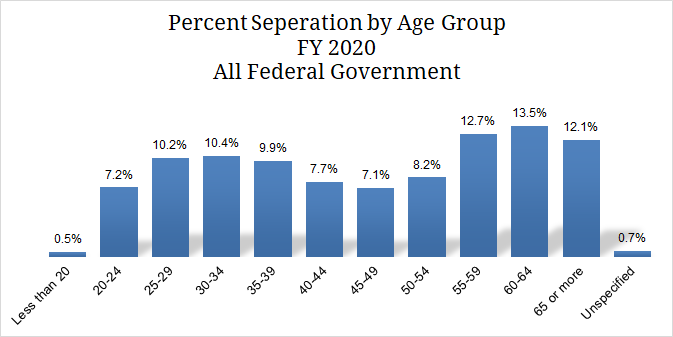
Percent Seperation by Age Group, FY 2020, All Federal Government Image Details
Source: OPM FedScope
Talent acquisition must be streamlined to keep pace with the private sector and other employers.
- Agencies The time to hire (T2H), weighted average, Government-wide has been about 100 days from fiscal year 2016 through fiscal year 2020. The days decreased by -9.6% from fiscal year 2016 to fiscal year 2020. This trend should be encouraged by agencies easing hiring practices. Decreasing the time to hire time should be prioritized across all Federal government agencies.
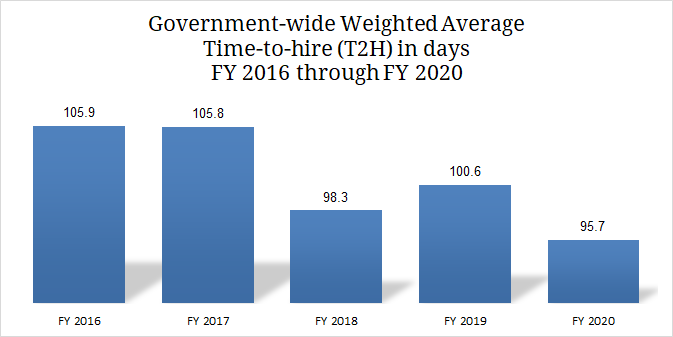
Source: OPM CHCO MCO Resource Charts
Retirements could significantly impact future government operations.
- Overall, 31.4% of Federal government employees will be eligible for retirement within five years. There were 14.8% eligible to retire from Federal government in 2020. Unsurprisingly, Federal employees are more likely to postpone retirement when they are satisfied with their agency leadership and their own position (Lewis and Pitts 2018). This highlights the importance of agency leadership in retaining talent to transfer knowledge.
- About half (15.7% ) of those eligible Federal employees (31.4%), as of 2020, are projected to retire in next five years (2020-2024).
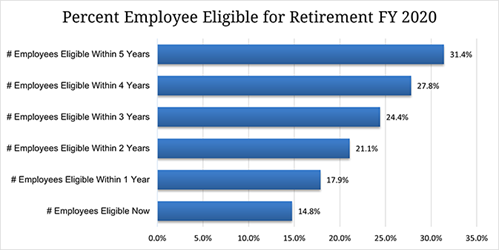
Percent Employee Eligible for Retirement FY 2020 Image Details
Source: OPM FedScope As of 9/24/21
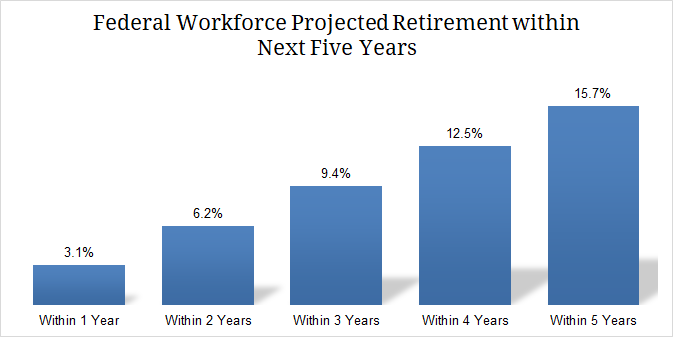
Source: OPM FedScope As of 9/24/21
Organizations must be prepared to address future events and resilient in the face of unknown challenges.
- According to OPM Federal Employee Viewpoint Survey 2020, the COVID-19 Pandemic was either slightly, somewhat, very, or extremely disruptive to three out of four, (75.3%), Federal workers’ ability to do their job. Only 24.7%, one in four, found the pandemic not at all disruptive to FEDS ability to do their work in FY 2020.
- Agencies should be better prepared and more resilient to disruptions and disorder.
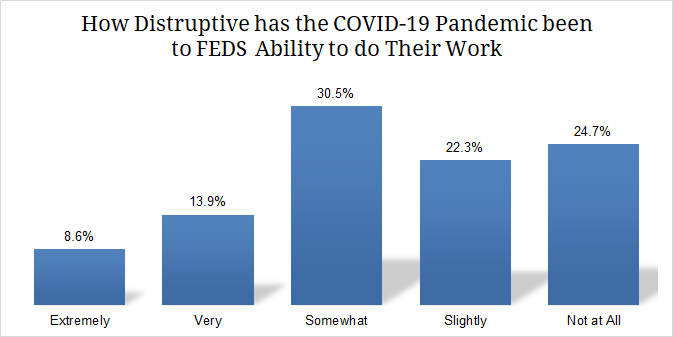
Source: OPM 2020 Federal Employee Viewpoint Survey-Q52
Tele, remote, and hybrid work are here to stay and will empower the workforce of the future.
- The rapid deployment of telework could improve employee engagement in the current COVID-19 pandemic as well as during other disruptive events. (Wells Fed Exec)
- Almost half, 45%, of the Federal government workforce is telework eligible as of Fiscal Year 2020. This telework eligibility rate should increase in preparation for future events. Agencies should promote greater resiliency, such as telework, to enhance national security.
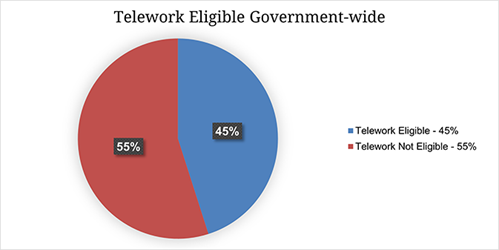
Source: OPM EHRI SDM Dec 2020
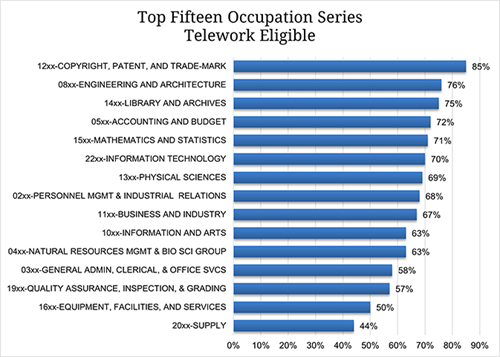
Top Fifteen Occupation Series Telework Eligible Image Details
Source: OPM EHRI SDM Dec 2020
Customer experience will be a critical enabler of service delivery in the future.
- Customer Experience (CX) is defined as the sum of all experiences a customer has with the agencies.
- Since the Federal government is often a sole-source service provider, CX is even more important in the public sector than in other organizations.
- By 2030, the US Federal government wants to reach the below outcomes:
- Customers rate satisfaction with Federal services comparable to private sector averages
- Federal programs able to identify the most important drivers of experience to the customer for types of services and transactions (for example service effectiveness, ease, efficiency, and equity/transparency)
- Significant increase in the public’s trust in the Federal government - agencies to collect and track measures of trust through customer feedback and can draw clear correlations between satisfaction and trust.
- Increased demand for workers with skills in data analysis, technology, as well as human-centered skills like customer service, training, and organizational development is expected.
- Increased demand for data analysis, technology, and human-centered skills linking customer service, training, and organizational development (CNES) (Volker Alliance 2018)
- Competition for and preparation for “digital natives” entering the workforce must consider both the benefits and possible displacement of older employees (NAPA 2018) (CNES) (Volker Alliance 2018)
References
For Federal Government Agencies, A New CX Mandate
https://www.performance.gov/cx/blog/reflection-on-Federal-customer-experience-efforts-in-2020/
The US Federal Customer Experience Index, 2020
Data will be a primary driver in how organizations make informed tactical, operational, and strategic decisions.
- Federal agencies often lack the data and evidence necessary to make critical decisions about program operations, policy, and regulations, and to gain visibility into the impact of resource allocation on achieving program objectives.
- The Foundations for Evidence-Based Policymaking Act of 2018 signed into law on January 14, 2019, emphasizes collaboration and coordination to advance data and evidence-building functions in the Federal Government by statutorily mandating Federal evidence-building activities, open government data, and confidential information protection and statistical efficiency.
- Agencies need to tap into, harness, and improve data collection to lay groundwork for AI/Automation adoption and augmentation (GAO-18-142SP).
- Agencies should promote the sharing of government data both across and outside Federal government.
- The use of AI and machine learning facilitates agencies to process their data more efficiently. Agencies need to leverage the required services, tools, and technologies to allow the workforce to achieve the desired outcomes. Going forward, Federal government needs for cloud services will continue to accelerate.
References
OMB launches Evaluation.gov as hub to showcase work from chief evaluation officers
Data and Statistics About the U.S.
Gartner: Enterprise use of AI grew 270% over the past 4 years
Foresight competencies and the ability to study the future can be a significant advantage for decisions makers.
- The Biden administration repeatedly emphasized their intention to battle multiple crises simultaneously: a “health crisis,” an “economic crisis,” a “racial justice crisis” and a “climate crisis.”
- In such an environment we need more than strategy. We need strategic foresight. Foresight does not predict the future, but rather explores the range of plausible futures that may emerge.
- Strategic foresight activities enable better preparedness, because they generate explicit, and flexible sense of the future and in so doing, makes it possible to identify and test assumptions we have about our current environment.
- Tools like scenario planning are used widely, if inconsistently, in business and government, yet the White House does not have a dedicated strategic-foresight function. Even though it is rapidly making high-stakes, difficult-to-reverse decisions that will have long-term effects, the U.S. government has no coordinated mechanism for imagining what those effects might be. If we don’t change that, we’ll always be battling surprise with spontaneity. By contrast, when we spend more time asking.
- Many government agencies lack a foresight office, much less a foresight capability. While intelligence activities may be strong, the ability to plan farther into the future for uncertainty beyond the 5-year budget planning horizon is not common.
References
We can’t prevent tomorrow’s catastrophes unless we imagine them today
We can’t prevent tomorrow’s catastrophes unless we imagine them today
The value of foresight and scenario-based planning for federal agencies
Rapidly evolving technology will force organizations to modernize IT systems and processes at the speed of innovation.
Modernizing IT Processes is on GAO high risk list as of March 2021.
- “Twenty-one of the 24 CFO Act agencies have not implemented IT management policies that fully address the roles of their chief information officers which includes ensuring that program staff have the necessary knowledge and skills to effectively acquire IT. Progress in establishing key IT workforce planning processes is also lacking.”
- GSA’s Office of Information Technology Category (ITC) is mandated to “maximize customer value and mission productivity through IT acquisition.” As the largest provider of IT acquisition solutions for government, GSA states it is absolutely critical that they ride the leading edge of IT innovation.
- IT modernization is a major focus of this administration. The President’s Executive Order on Improving the Nation’s Cybersecurity requires a safe, secure, and sustainable Federal government’s IT infrastructure. Agencies need to have more modernized and secure IT infrastructures and away from legacy technologies that are vulnerable to security risks.
References
https://www.nextgov.com/ideas/2021/04/jumpstarting-Federal-it-modernization-new-
Enterprise Infrastructure Solutions
Strategic Human Capital Management
Cost Estimating and Assessment Guide
Employee Engagement
Unlocking workforce engagement potential is critical to achieving a high-performing 21st century workforce.
- The Office of Personnel Management’s Survey Analysis (SA) group studies are a key to achieving the 21st century workforce goals. The SA group research summarizes five key drivers to unlocking the Federal workforce engagement potential (FEVS OPM).
- performance feedback,
- collaborative management,
- merit system principle,
- training and development,
- work life balance.

Federal Workforce Engagement Fiscal Year 2020 Image Details
Source: 2020 Federal Employee Viewpoint Survey
Employee Engagement
During the analysis of Federal Employee Viewpoint Survey questions, we noticed that ones we believe are related to the workforce priorities showed increases in employee engagement scores from 2017 - 2020. Prior to that, the scores had either decreased or had remained roughly flat. We surmised that with the publication of the first FWPR in 2018 and the requirement that agencies work on two priorities, the engagement scores increased because agencies were applying resources and effort to the identified priorities. The 2022 FWPR priorities crosswalk to the 2018 priorities and our assertion is that if agencies continue to work on the new priorities, the effort will continue to increase employee engagement scores. Our conclusion is that the correct priorities were identified in 2018 and the new priorities are an extension of that success. We also feel that the FWPR construct could be used to address other areas that need improvement.
Priorities Crosswalk
Each priority from the 2018 report is directly linked a priority from the 2022 report.
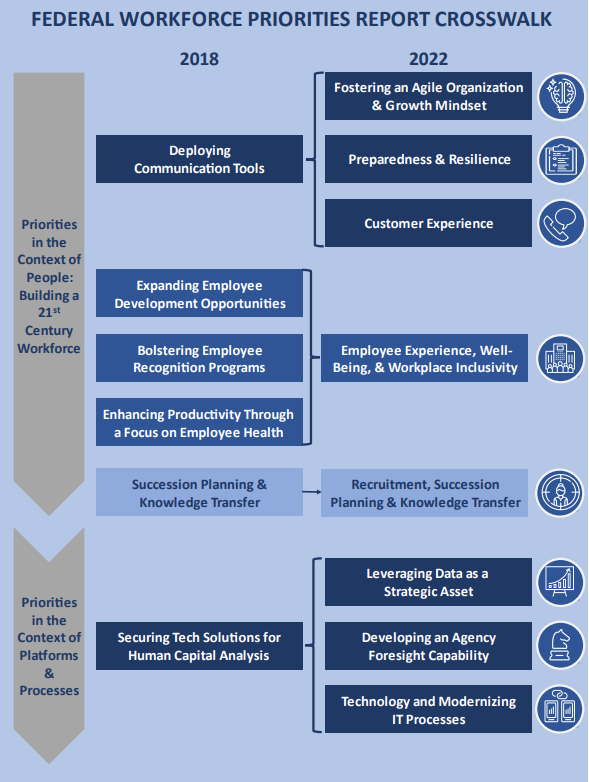
View the Priorities Crosswalk chart in 2022 Federal Workforce Priorities Report - Page 30
2018 FWPR Questions
Q53 In my organization, senior leaders generate high levels of motivation and commitment in the workforce.
Q31 Employees are recognized for providing high quality products and services.
Q58 Managers promote communication among different work units (for example, about projects, goals, needed resources)
Q45 My supervisor is committed to a workforce representative of all segments of society.
Priority 1: Leveraging Technology & Modernizing IT Processes
| FEVS Question | 2011-2016 Change | 2013-2016 Change | 2017-2020 Change |
|---|---|---|---|
|
Q1: I am given a real opportunity to improve my skills in my organization. |
-3.84% |
+2.90% |
+5.80% |
|
Q21: Supervisors in my work unit support employee development. |
-1.94% |
+1.60% |
+10.10% |
|
Q58: How satisfied are you with the Telework program in your agency? |
No Data |
No Data |
+16.40% |
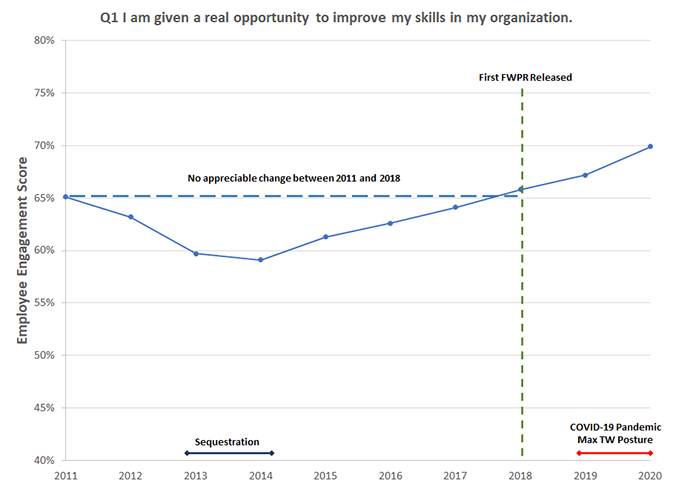
Q1 I am given a real opportunity to improve my skills in my organization Image Details
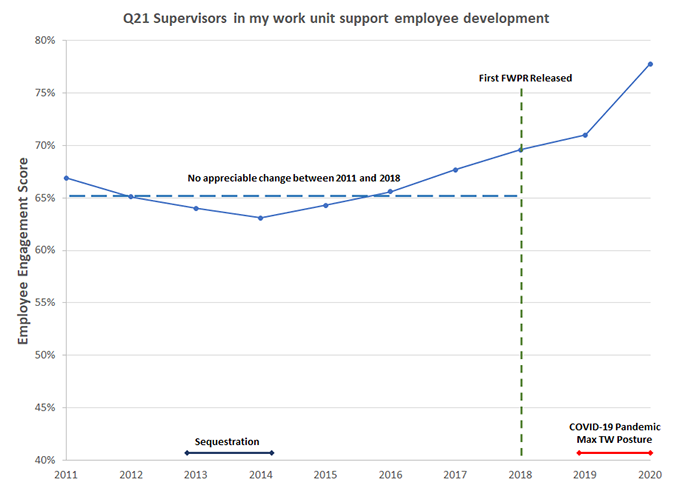
Q21 Supervisors in my work unit support employee development Image Details
Priority 2: Recruitment, Succession Planning, & Knowledge Transfer
| FEVS Question | 2011-2016 Change | 2013-2016 Change | 2017-2020 Change |
|---|---|---|---|
|
Q29: Managers promote communication among different work units (for example, about projects, goals, needed resources). |
-5.80% |
-0.30% |
+4.80% |
|
Q26: In my organization, senior leaders generate high levels of motivation and commitment in the workforce. |
-9.11% |
+0.10% |
+7.60% |
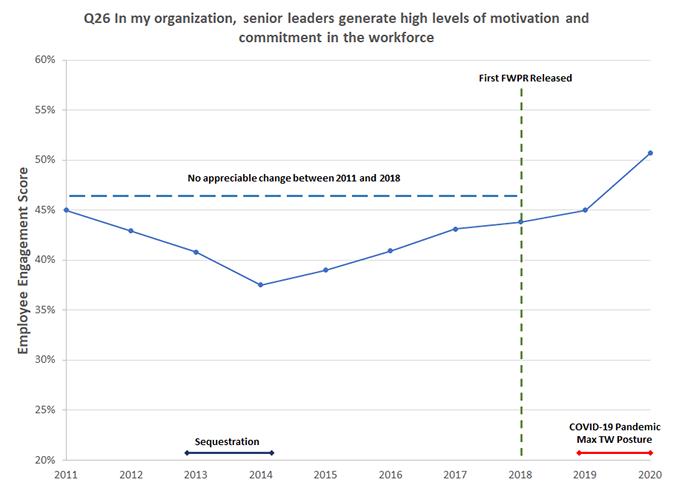
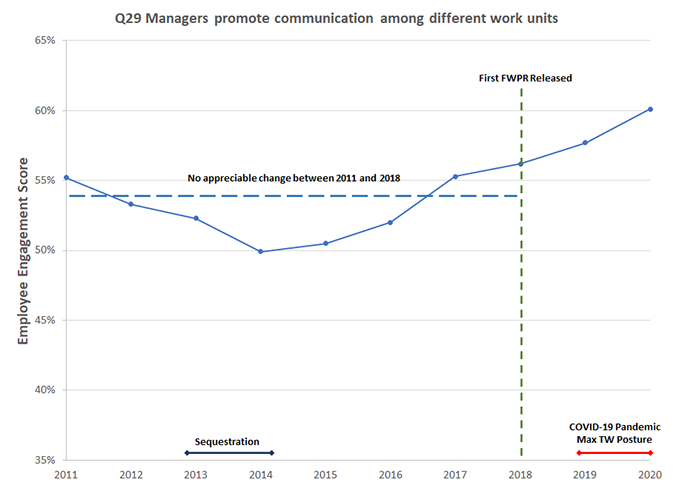
Q29 Managers promote communication among different work units Image Details
Priority 3: Enhancing Employee Experience, Fostering Employee Well-Being, and Building a Diverse and Inclusive Workforce
| FEVS Question | 2011-2016 Change | 2013-2016 Change | 2017-2020 Change |
|---|---|---|---|
|
Q19: My supervisor supports my need to balance work and other life issues. |
+1.42% |
+1.10% |
+4.90% |
|
Q20: My supervisor is committed to a workforce representative of all segments of society. |
+2.73% |
+3.20% |
+9.30% |
|
Q23: My supervisor treats me with respect. |
+1.37% |
+1.60% |
+4.00% |
|
Q35: How satisfied are you with the recognition you receive for doing a good job? |
-6.31% |
+2.10% |
+8.60% |
|
Q14: Employees are recognized for providing high quality products and services. |
-3.50% |
+2.40% |
+13.50% |
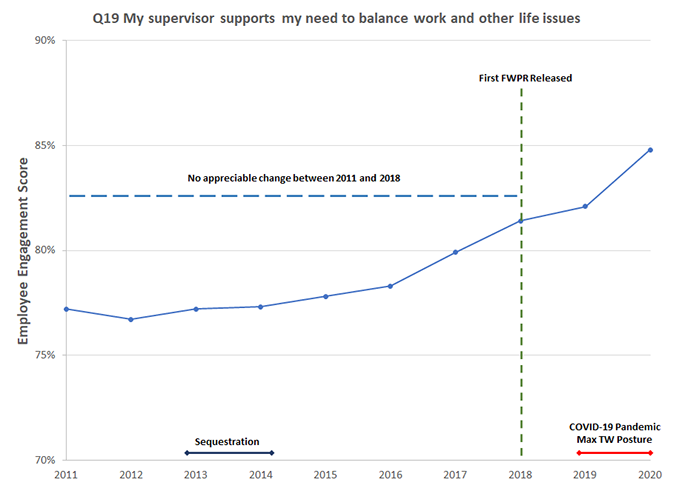
Q19 My supervisor supports my need to balance work and other life issues Image Details
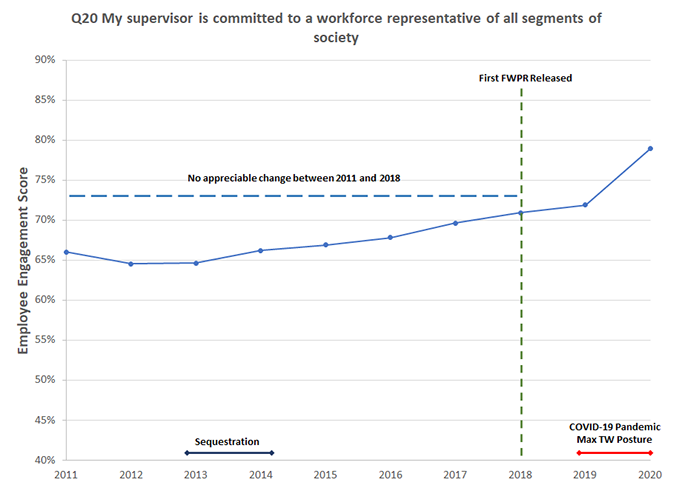
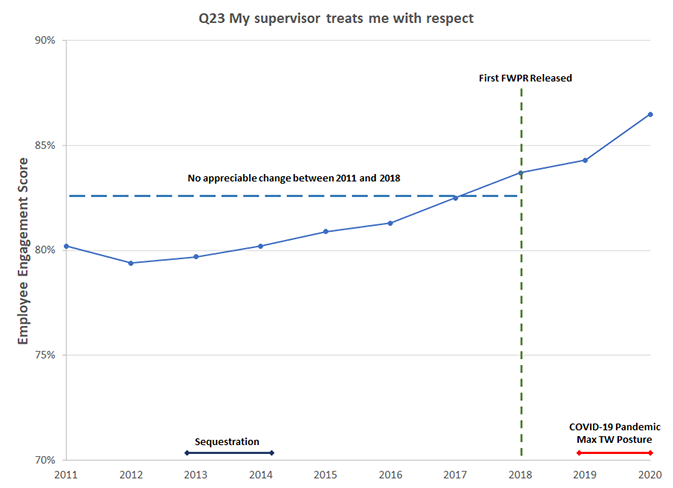
Q23 My supervisor treats me with respect Image Details
Q35 How satisfied are you with the recognition you receive for doing a good job?
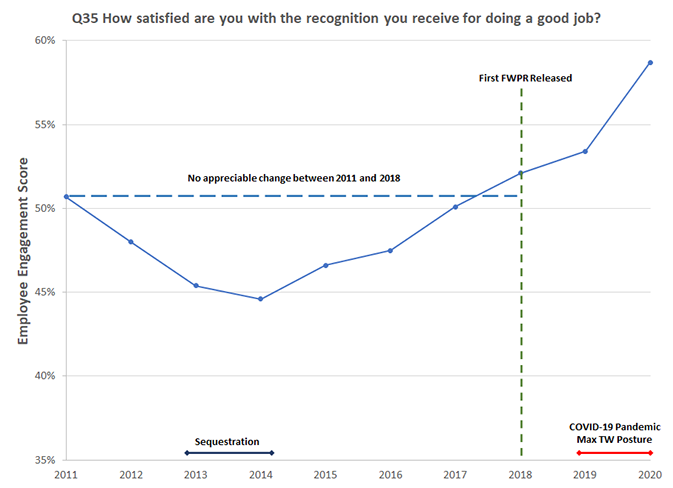
Q35 How satisfied are you with the recognition you receive for doing a good job? Image Details
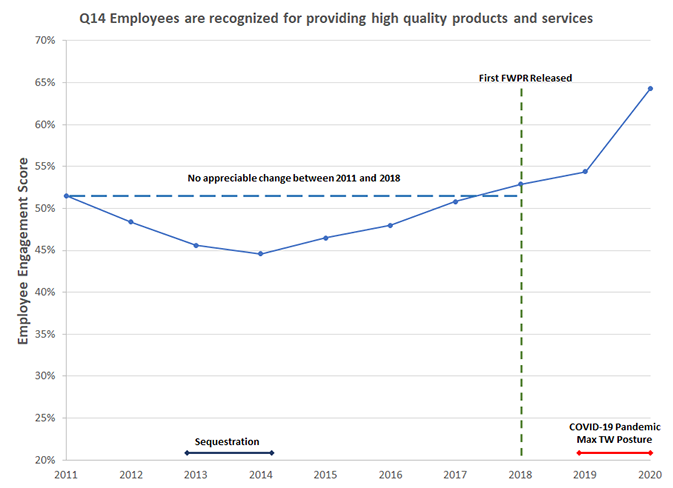
Q14 Employees are recognized for providing high quality products and services Image Details
Priority 4: Fostering and Agile Organization & the Growth Mindset
| FEVS Question | 2011-2016 Change | 2013-2016 Change | 2017-2020 Change |
|---|---|---|---|
|
Q13: My work unit has the job-relevant knowledge and skills necessary to accomplish organizational goals. |
No Data |
No Data |
+1.80% |
|
Q16: My agency is successful at accomplishing its mission. |
-6.21% |
-0.40% |
+5.10% |
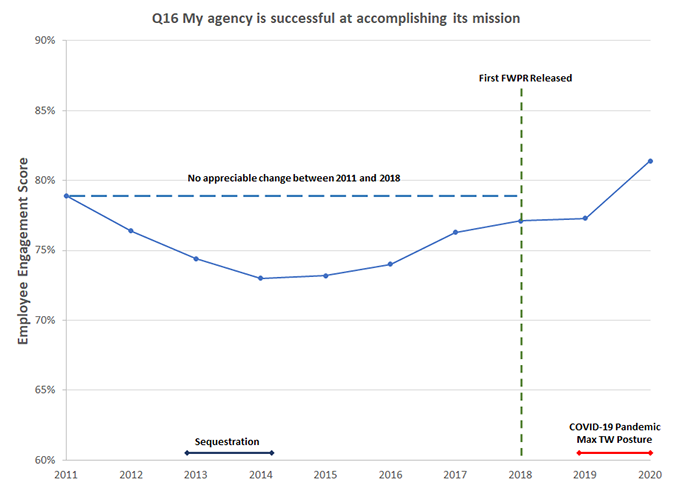
Q16 My agency is successful at accomplishing its mission Image Details
Priority 5: Enhancing Customer Experience
| FEVS Question | 2011-2016 Change | 2013-2016 Change | 2017-2020 Change |
|---|---|---|---|
|
Q38: Considering everything, how satisfied are you with your organization? |
-8.67% |
+1.30% |
+9.52% |
|
Q54a: Performance Confidence Index - My Work Unit met / has met the needs of our customers. |
No Data |
No Data |
Prior: 94% always or most of the time During: 86% always or most of the time |
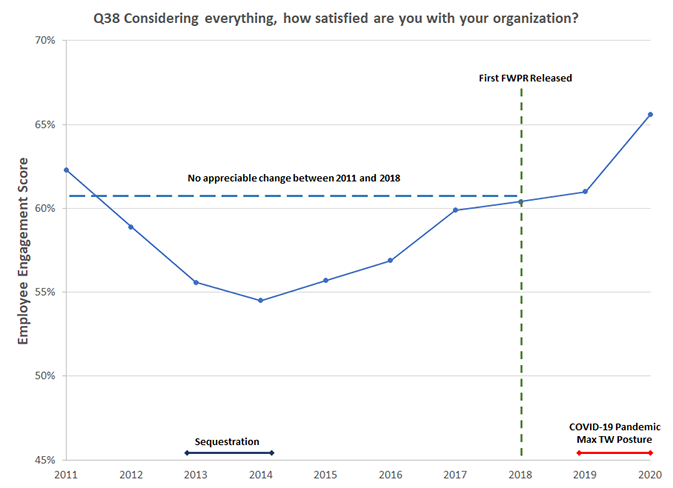
Q38 Considering everything, how satisfied are you with your organization? Image Details
Priority 6: Leveraging Data as a Strategic Asset
| FEVS Question | 2011-2016 Change | 2013-2016 Change | 2017-2020 Change |
|---|---|---|---|
|
Q18: I believe the results of this survey will be used to make my agency a better place to work. |
-9.71% |
+2.60% |
+1.10% |
|
Q34: How satisfied are you with the information you receive from management on what is going on in your organization? |
-5.33% |
+0.40% |
+7.5% |
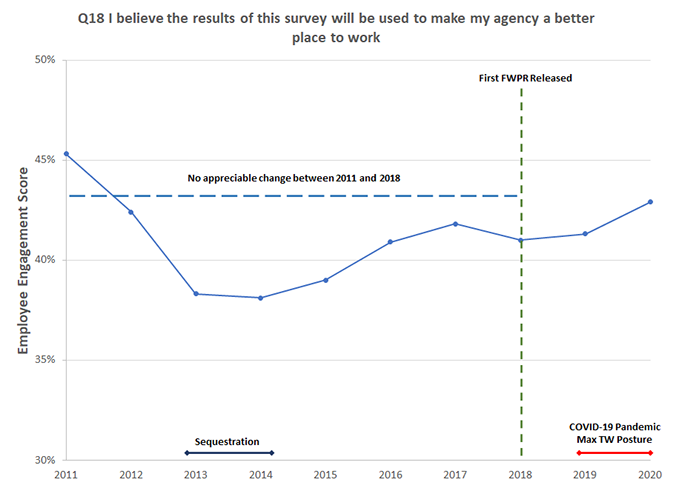
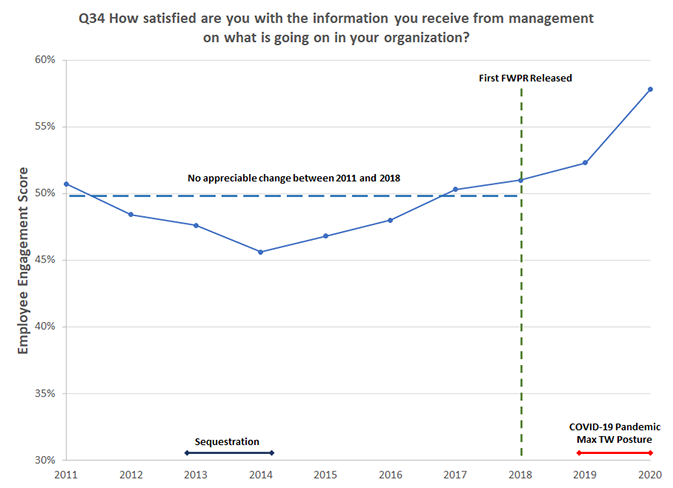
Employee Resilience
Here's what the numbers tell us about employee resilience. Nearly a quarter of respondents said that the pandemic had been extremely or very disruptive to their ability to get their work done. And 48% said that their work demands have either greatly or somewhat increased. Despite battling higher workloads and disruption to their work, employee confidence in their work unit’s performance remained high. This measures things like the ability to continue producing high-quality work and meeting customers' needs. It took a slight dip, compared with pre-COVID-19 numbers, but was still high. That really speaks, we think, a lot to the resilience of the workplace. Federal employees reported that a key driver of workforce resilience came from front-line supervisors taking an active role in supporting their employees, especially regarding health, safety, and work-life needs.
Responses on the FY 2020 FEVS reflected the resilience of employees during an unprecedented time. Based on the survey results, the federal workforce demonstrated that, despite the uncertainties and hardships encountered throughout COVID-19, they remain committed to accomplishing critical work to ensure that public services continued to be delivered to the American people.
Priority 7: Preparedness & Resilience
| FEVS Question | 2011-2016 Change | 2013-2016 Change | 2017-2020 Change |
|---|---|---|---|
|
Q26: In my organization, senior leaders generate high levels of motivation and commitment in the workforce. |
-9.11% |
+0.10% |
+7.60% |
|
Q27: My organization's senior leaders maintain high standards of honesty and integrity. |
-5.20% |
-1.80% |
+6.60% |
|
Q54: My Work Unit adapted / has adapted to changing priorities. |
No Data |
No Data |
Prior: 90% always or most of the time During: 87% always or most of the time |

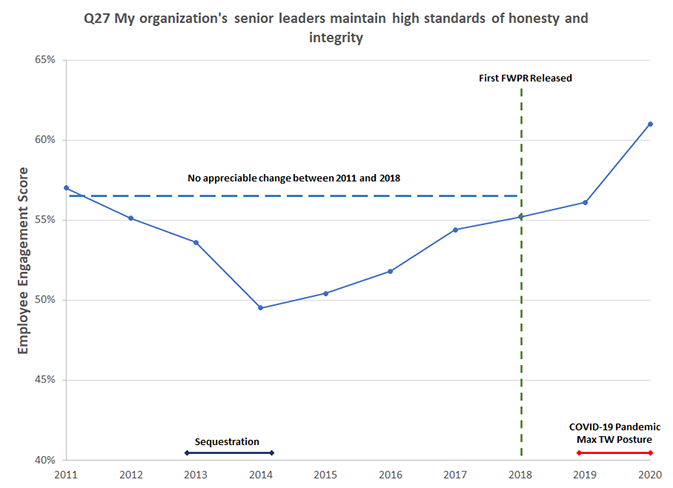
Q27 My organization's senior leaders maintain high standards of honesty and integrity Image Details
Priority 8: Developing and Agency Foresight Capability
| FEVS Question | 2011-2016 Change | 2013-2016 Change | COVID-19 |
|---|---|---|---|
|
Q28: Managers communicate the goals of the organization. |
-4.10% |
-0.90% |
+5.20% |
|
Q52: How disruptive has the COVID-19 pandemic been to your ability to do your work? |
No Data |
No Data |
Disruption Extremely: 9% Very: 14% Somewhat: 30% Slightly: 22% Not at all: 25% |
|
Q57: Based on my organization’s handling of the COVID-19 pandemic, I believe my organization will respond effectively to future emergencies. |
No Data |
No Data |
Future Response Strongly Agree: 36% Agree: 37% Neutral: 15% Disagree: 6% Strongly Disagree: 5% |
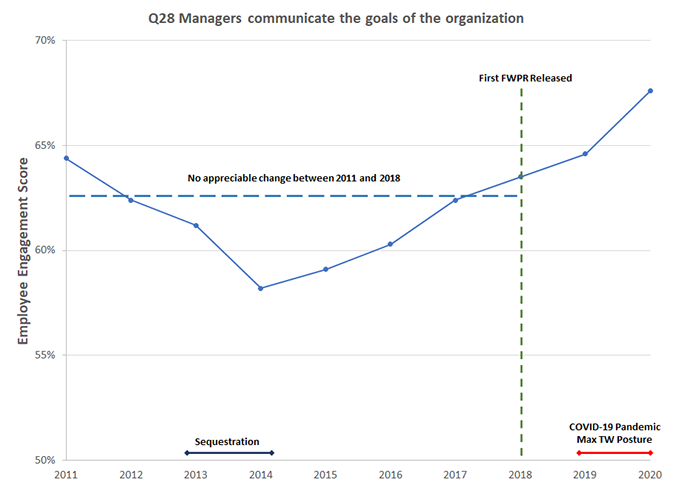
Q28 Managers communicate the goals of the organization Image Details
Promising Agency Practices
The programs and initiatives listed below have been undertaken by Federal agencies in areas that support the priorities listed in this report. They are intended to serve as a sample of examples and help generate ideas for other agencies when planning their own efforts in support of this report.
OPEN OPPORTUNITIES
Federal leaders face a variety of challenges, from supporting important agency-wide initiatives and programs, to focusing on employee engagement and retention. Open Opportunities can provide the tools to support your office needs, engage your employees, and provide meaningful development opportunities.
Open Opportunities is a skills-based, government-wide collaboration, professional development, and networking platform. The goal of Open Opportunities is to create a culture of excellence by implementing a new model of a mobile, agile, innovative, and skilled federal workforce that is based on team collaboration and responsiveness to mission demands, rather than being unnecessarily limited by organizational silos.
With a mission to strengthen, engage, and connect the federal workforce through employee development, Open Opportunities wants to ensure the needs of the current and future federal workforce are met. Novel and innovative approaches are part of this process. The platform has introduced cutting edge technology that automatically matches users to opportunities based on skills data in opportunity postings and user profiles. The innovative mindset of Open Opportunities is not only revolutionizing the way we develop our nation’s largest workforce, but it is also building the future of job searching for a 21st century government.
OPM believes that Open Opportunities will be a force multiplier for agencies as they look for ways to address these priorities. Agencies are encouraged to explore and use the platform to meet their needs, address their challenges, and leverage opportunities.
ON THIS PAGE
Leveraging Data Technology and Modernizing IT Processes

Resources.Data.Gov
Recruitment, Succession Planning, and Knowledge Transfer
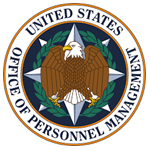
Executive Women in Motion Mentoring

U.S. Environmental Protection Agency Mentoring Program
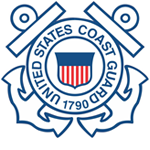
U.S. Coast Guard Mentoring Program
Enhancing Employee Experience, Fostering Employee Well-Being, and Building a Diverse and Inclusive Workforce

VA Employee Experience Efforts

Cybersecurity & Infrastructure Security Agency Project Reach

Cybersecurity & Infrastructure Security Agency Non-Traditional Training Grant Provider (NTTP)
Fostering and Agile Organization and the Growth Mindset
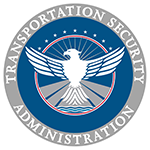
TSA Sensitive Security Information App
Enhancing Customer Experience

VA Customer Experience Efforts
Leveraging Data as a Strategic Asset
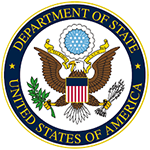
Overseas Staffing Model
Preparedness and Resilience
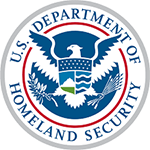
Baseline Assessment Scoring Tool
Developing an Agency Foresight Capability

USAID Foresight Cell
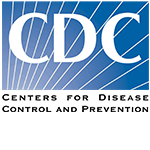
CDC Strategic Foresight Learning & Action Network (SF-LAN)




